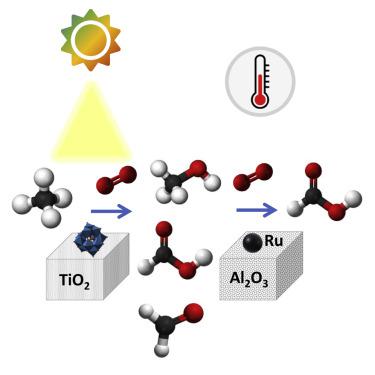Cell Reports Physical Science ( IF 7.9 ) Pub Date : 2023-01-30 , DOI: 10.1016/j.xcrp.2023.101277 Di Hu , Ahmed Addad , Karima Ben Tayeb , Vitaly V. Ordomsky , Andrei Y. Khodakov

|
Direct conversion of methane into fuels and chemicals remains a major challenge in modern science. Formic acid is one of the most promising platform molecules. Photocatalysis proposes an attractive route for methane partial oxidation under mild conditions. The radical mechanism of methane photocatalytic oxidation restricts the selectivity to target products. In this article, we propose a strategy to break conventional limitations of methane photocatalytic oxidation by adding a thermocatalyst and conducting the process in a one-pot reactor. In this strategy, the methane selective conversion into formic acid proceeds first over cesium salt of phosphotungstic acid on titania, which photocatalytically oxidizes methane into a mixture of C1 oxygenates. These oxygenates are then selectively converted into formic acid over a heterogeneous alumina-supported ruthenium catalyst. All reactions occur at room temperature in the same reactor. A selectivity to formic acid of 85% and a productivity of 5 mmol g−1photocatalyst are achieved.
中文翻译:

热催化能够在室温下将甲烷光催化氧化为甲酸,超出选择性限制
将甲烷直接转化为燃料和化学品仍然是现代科学面临的主要挑战。甲酸是最有前途的平台分子之一。光催化提出了一种在温和条件下进行甲烷部分氧化的有吸引力的途径。甲烷光催化氧化的自由基机理限制了对目标产物的选择性。在这篇文章中,我们提出了一种策略,通过添加热催化剂并在单锅反应器中进行该过程来打破甲烷光催化氧化的传统限制。在该策略中,甲酸选择性转化为甲酸首先在二氧化钛上通过磷钨酸的铯盐进行,二氧化钛将甲烷光催化氧化为 C 1的混合物氧化。然后,这些含氧化合物在多相氧化铝负载的钌催化剂上选择性地转化为甲酸。所有反应都在室温下发生在同一反应器中。实现了85% 的甲酸选择性和 5 mmol g -1光催化剂的生产率。





















































 京公网安备 11010802027423号
京公网安备 11010802027423号